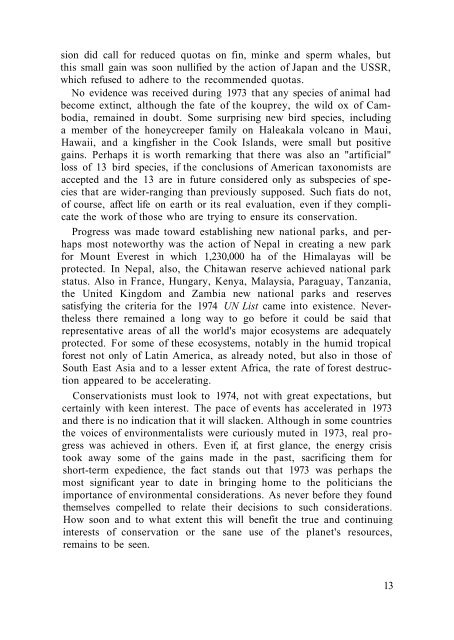1973 iucn yearbook
1973 iucn yearbook
1973 iucn yearbook
Create successful ePaper yourself
Turn your PDF publications into a flip-book with our unique Google optimized e-Paper software.
sion did call for reduced quotas on fin, minke and sperm whales, but<br />
this small gain was soon nullified by the action of Japan and the USSR,<br />
which refused to adhere to the recommended quotas.<br />
No evidence was received during <strong>1973</strong> that any species of animal had<br />
become extinct, although the fate of the kouprey, the wild ox of Cambodia,<br />
remained in doubt. Some surprising new bird species, including<br />
a member of the honeycreeper family on Haleakala volcano in Maui,<br />
Hawaii, and a kingfisher in the Cook Islands, were small but positive<br />
gains. Perhaps it is worth remarking that there was also an "artificial"<br />
loss of 13 bird species, if the conclusions of American taxonomists are<br />
accepted and the 13 are in future considered only as subspecies of species<br />
that are wider-ranging than previously supposed. Such fiats do not,<br />
of course, affect life on earth or its real evaluation, even if they complicate<br />
the work of those who are trying to ensure its conservation.<br />
Progress was made toward establishing new national parks, and perhaps<br />
most noteworthy was the action of Nepal in creating a new park<br />
for Mount Everest in which 1,230,000 ha of the Himalayas will be<br />
protected. In Nepal, also, the Chita wan reserve achieved national park<br />
status. Also in France, Hungary, Kenya, Malaysia, Paraguay, Tanzania,<br />
the United Kingdom and Zambia new national parks and reserves<br />
satisfying the criteria for the 1974 UN List came into existence. Nevertheless<br />
there remained a long way to go before it could be said that<br />
representative areas of all the world's major ecosystems are adequately<br />
protected. For some of these ecosystems, notably in the humid tropical<br />
forest not only of Latin America, as already noted, but also in those of<br />
South East Asia and to a lesser extent Africa, the rate of forest destruction<br />
appeared to be accelerating.<br />
Conservationists must look to 1974, not with great expectations, but<br />
certainly with keen interest. The pace of events has accelerated in <strong>1973</strong><br />
and there is no indication that it will slacken. Although in some countries<br />
the voices of environmentalists were curiously muted in <strong>1973</strong>, real progress<br />
was achieved in others. Even if, at first glance, the energy crisis<br />
took away some of the gains made in the past, sacrificing them for<br />
short-term expedience, the fact stands out that <strong>1973</strong> was perhaps the<br />
most significant year to date in bringing home to the politicians the<br />
importance of environmental considerations. As never before they found<br />
themselves compelled to relate their decisions to such considerations.<br />
How soon and to what extent this will benefit the true and continuing<br />
interests of conservation or the sane use of the planet's resources,<br />
remains to be seen.<br />
13

















